As the evaluation project nears the deadline, the possibility of a rushed, wrong decision is high. Remember it doesn’t just cost the company the price of the software – there’s money involved in its maintenance, in its ability to save dollars by preventing downtime and your next increment too is at stake 🙂
This blog is to highlight some of the common mistakes we do when evaluating and selecting a network monitoring solution.
#1: Ambiguous network management goal
 If you were to list down what you want to monitor in your network and the top 10 network issues you had in the past, you’ll find some of the most critical needs missing in monitoring needs outlined. It is better to start with identifying the needs and check if the solution addresses those, than focusing on the list of features that you wish to see.
If you were to list down what you want to monitor in your network and the top 10 network issues you had in the past, you’ll find some of the most critical needs missing in monitoring needs outlined. It is better to start with identifying the needs and check if the solution addresses those, than focusing on the list of features that you wish to see.
#2: Selecting unfamiliar technology that has steep learning curve A typical scenario is, when the upper management decides to choose a network monitoring solution which is not easily usable or involves expensive consulting, leading to longer deployment period.
A typical scenario is, when the upper management decides to choose a network monitoring solution which is not easily usable or involves expensive consulting, leading to longer deployment period.
You might want to ask your engineers what they are comfortable with; for instance, “are you fine working with black screen consoles or do you prefer a rich GUI”
Second, the solution must not be rocket science; even a new-hire must be able to use without much assistance. The IT teams are dynamic and it is impractical to expect the same level of understanding and comfort-level between administrators. For example think of a situation where an administrator was given a Linux based network monitoring solution, when he has been working all along on Windows.
A practical scenario: The IT Manager was an expert in script and configuring XML files, but after he moved higher up the existing team found it to be hard to manage the script and XML files to keep-up with their growing need
#3: Failing to visualize the infrastructure and its readiness
 It is easy for one to be overwhelmed by the size of the network and its components when deciding on a solution that can manage the same. A good beginning is to understand the big picture of your network that you plan to monitor; the network topology, connectivity between the remote sites, the core devices etc.. This visibility lets you decide on the specifics such as where to install the solution, which ports to open, what protocols need to be enabled, etc.. One can even save on bandwidth costs by deploying the solution at an optimal point in the network.
It is easy for one to be overwhelmed by the size of the network and its components when deciding on a solution that can manage the same. A good beginning is to understand the big picture of your network that you plan to monitor; the network topology, connectivity between the remote sites, the core devices etc.. This visibility lets you decide on the specifics such as where to install the solution, which ports to open, what protocols need to be enabled, etc.. One can even save on bandwidth costs by deploying the solution at an optimal point in the network.
#4: Failing to factor-in future changes
 Ignoring to plan ahead for a possible expansion in future or other changes can prove costly. For instance, if your enterprise is preparing to virtualize the complete server environment, make sure you choose a solution that can be installed on virtual machines and also has the capabilities to monitor the virtualized environment.
Ignoring to plan ahead for a possible expansion in future or other changes can prove costly. For instance, if your enterprise is preparing to virtualize the complete server environment, make sure you choose a solution that can be installed on virtual machines and also has the capabilities to monitor the virtualized environment.
Have you experienced the same? Do you have more ‘I-should-have-thought-about’ moments to share about your last network monitoring solution purchase? Post your comments or feel free to write to me at kalvin@manageengine.com.
Kalvin
Team OpManager
www.opmanager.com
The network monitoring software from ManageEngine


Pingback: ネットワーク監視ツールを選定するときの注意点 | ManageEngine ブログ